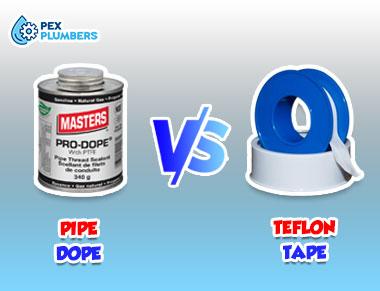Are you a professional plumber? Or perhaps, you are among the many homeowners that love doing their plumbing work around the house? If yes, you probably already know the importance of using pipe dope or Teflon tape anytime you’ve to connect threaded joints together.
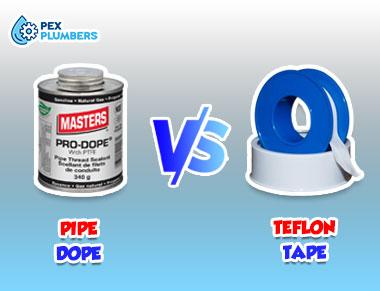
However, while these two sealants do the same thing which is to prevent leaks, they are not equally the same.
They differ in their form, range of application, seal strength, and ease of use.
Therefore, you must choose the right one based on the project you’re working on.
But how do you know which between pipe dope Vs Teflon tape is best for your needs? Let’s find out their differences to help you decide which one to choose.
Comparison Chart of Pipe Dope Or Teflon Tape
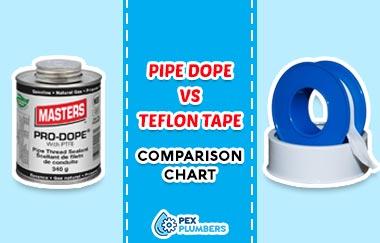
Not sure whether to use old-school pipe dope or Teflon tape for your pipe connections? Below is our head-to-head comparison of these two sealants to help you make the right choice.
| Pipe Dope | Teflon Tape | |
| Form | Comes in putty-like adhesive or simply thick paste form | Available in thin stretchy and rolled film |
| Permanency | Hard to remove and replace your fittings | Easy to remove and repair your fittings |
| Application | Best when connecting natural gas pipers, reactive metals, steel, and large-diameter pipes | Best suited for plastic, unreactive metals, small diameter pipes, and soft metals connections |
| Strength | Offers a stronger seal | Less strong than pipe dope |
| Ease of use | Easy but a little messy | Needs some level of skill but it’s mess-free |
| Types available | Two | At least five |
| Pricing | Inexpensive | A little pricier depending on the brand |
Why Is It Called Pipe Dope?
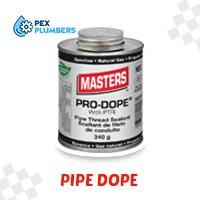
The word dope has several meanings. However, one of these meanings is to smear or cover something with varnish or even a thick liquid paste. As you might know, pipe dope comes in the form of a thick paste comprising a mixture of various substances.
You can apply the paste on any threaded pipe as a sealant. Since it is formulated to be used on pipes, it is, therefore, referred to as pipe dope, an old-school name.
Besides using it on natural gas pipes, you can smear the dope on copper and galvanized steel pipes.
What Does Pipe Dope Do?
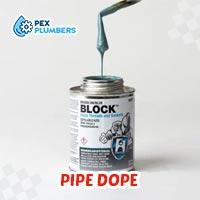
Also referred to as pipe joint compound, pipe dope is a chemical sealant. What the compound does is seal the threaded joints of pipes and other fittings. In other words, it forms an airtight or watertight seal when applied to pipes.
You just need to apply a thin paste of this compound onto the male threads of your fittings. Then, attach your pipes to the fittings, and over time the compound will dry up to create a watertight seal. Consequently, this helps prevent any kind of leaking.
But besides working as a sealant, old-school pipe dope also acts as a lubricant thanks to its non-hardening properties. This comes in handy when you have to unthread your pipes. It also works as a lubricant when you’re installing a compression stop on copper water lines.
Why Is It Called Teflon Tape?

Teflon is a brand name for the polytetrafluoroethylene (PTFE) material. Or simply a Dupont trade name commonly used as a non-stick coating for cookware and pans. Surprisingly, Teflon’s manufacturer has never made the material in tape form.
The truth is that other tape manufacturers are allowed to use the name Teflon to create their plumber’s tape. However, these manufacturers must make their tapes using only real Teflon.
This explains why it is called Teflon tape. Therefore, all the different brands of Teflon tape you’ll come across are not in any way associated with the Teflon trademark.
What Does Teflon Tape Do?
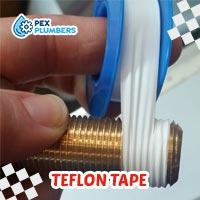
Also referred to as pipe thread sealant tape, Teflon tape works by sealing the threads of different plumbing components. For instance, you could use yellow tape to seal gas lines and green tape to thread oxygen lines.
Or, you can use gray tape for stainless steel threads and pink tape to seal water lines. In other words, what this tape does is create a tight seal between plumbing parts in an attempt to prevent leaking.
The tape helps stop the leaks by simply clogging the thread path. You just need to wrap it around the threaded joint of your pipes or fittings in the same direction.
Similar to old-school pipe dope, Teflon tape can also work as a lubricant. Simply put, it helps lubricate the sealing joints of your pipes. This is thanks to its low-friction properties.
Therefore, in case you ever want to replace your fittings or piping in the future, you could easily do so.
Teflon Tape vs Pipe Dope: What Are The Differences?
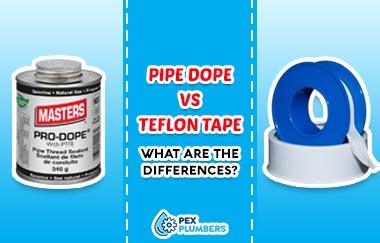
By now, you probably already have an idea about the features that set pipe dope and pipe thread sealant apart. So, in this section, we will look at their differences in detail.
● Form
Pipe dope is a mixture of various substances, including vegetable oil, ethanol, kaolin clay, and rosin. These substances are usually combined to form a thin pasty-like compound that comes in a can or tube.
Meanwhile, Teflon tape comes in the form of a thin and non-sticky film. The tape is made of polytetrafluoroethylene materials. But in some cases, the tape may be made from polyethylene, a low-cost plastic.
Unlike a pipe joint compound, Teflon tape comes spooled in the form of a roll similar to masking or electrical tape.
● Applications
Both sealants boast a wide range of applications. However, because of its stronger seal, pipe dope is best for sealing small and large-diameter pipes.
Also, it is best suited for use on water or gas pipes buried underground or that run beneath your house. This is to say that pipe dope works with all types of fitting and pipe materials.
When it comes to Teflon tape, it is not as strong as the old-school pipe dope. As such, it has been approved for specific types of plumbing applications, including standard water fittings and pipes.
You can also find Teflon tape for gas lines, water lines, oxygen lines, stainless steel threads, and general plumbing jobs.
● Ease of use
Pipe dope for gas lines is the easiest to use of these two sealants. This is probably because it has been around for longer and is popular among many plumbers.
You only need to apply the dope on your pipe threaded ends using a brush or even your hand. Also, you could use some other tool such as a spatula or a piece of wood. On the flip side, though, using a pipe joint compound can be messy.
Teflon tape is also easy to use, and most people swear by this. Even so, you need some level of skill to use it. It is not as simple as simply wrapping it around your pipe.
This is because you just can’t apply the tape in any direction. You need to wrap the tape in a clockwise direction or follow the thread of your fittings.
More so, you must know how many wraps of tape to apply because using too much or little can cause leaking. The good thing with pipe thread sealant is that it’s not messy like pipe dope.
● Permanency
For permanent connections, most professional plumbers prefer using pipe dope because of its ability to create a stronger seal. This means that if you want to remove and replace your fittings, it can be difficult.
Teflon tape, on the other hand, is commonly used to seal fittings and pipes that may need to be replaced occasionally. This is because it does not form a strong seal similar to pipe dope.
So, if your water lines have leaks, you can easily remove the damaged parts and make the necessary repairs.
● Types available
You can find pipe dope in two different types. One is for general use or simply universal. This means you can use it on all types of pipes and fitting materials, including plastic.
However, for some universal pipe dope for gas lines, you cannot use them with plastic pipes. The sealant could damage your plastic fittings. Another type of pipe dope sealant is one designed specifically for plastic connections.
With Teflon tape, you can find it in five different types or color options. These include white, pale pink, yellow, green, and gray-colored tape. White is considered the standard color and is best for basic plumbing tasks.
As for pink, the tape is relatively more heavy-duty than white and is recommended for water lines.
You use the yellow-colored Teflon tape to seal different gas lines like natural gas, propane, and butane. On the other hand, green pipe thread sealant tape is for oxygen lines and gray for steel threads.
Which One Should You Choose?
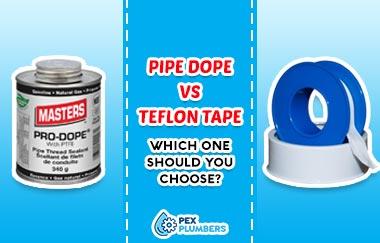
Overall, pipe dope seems like the most preferred option even among professional plumbers. This is because it offers a stronger seal than its Teflon tape counterpart.
As such, you can use it to seal pipes and fittings made of different materials and diameters. Another reason why you should choose the pipe joint compound over Teflon tape is its ease of application.
After all, there is nothing like following a certain direction when applying it or counting how many wraps you make. Even better, pipe dope is inexpensive, corrosion-resistant, and it’s easy to find.
Frequently Asked Questions
1. How to Use Teflon Tape to Stop Leaks?
If you have a leaky pipe or fitting, Teflon tape is an easy way to stop the leak. Just apply the tape around the threads of the pipe or fitting, and it will create a seal that will prevent water from leaking out. You can also use Teflon tape to seal up any cracks or holes in your pipes.
2. When To Use Teflon Tape?
If you’re working with any type of plumbing, it’s important to know when to use Teflon tape. This type of tape is specifically designed to create a watertight seal, and it can be used on a variety of different materials. Here are a few tips on when to use Teflon tape:
3. When Not To Use Teflon Tape?
Teflon tape is often used to seal threaded connections, but there are a few instances where it shouldn’t be used. Here are four instances where Teflon tape shouldn’t be used:
(i) When the Connection is Under Pressure: Teflon tape works by creating a seal between two surfaces when they’re screwed together. However, this seal isn’t strong enough to withstand pressure. If there’s any chance that the connection could be under pressure, don’t use Teflon tape.
(ii) When the Connection is Hot: Teflon tape can start to break down at temperatures above 500 degrees Fahrenheit. So, if the connection is going to be exposed to high temperatures, don’t use Teflon tape.
(iii) When the Connection is Chemical Resistant: Teflon tape is made of polytetrafluoroethylene (PTFE), which is a type of plastic. This means that it can be dissolved by some chemicals. So, if the connection will be exposed to chemicals, don’t use Teflon tape.
(iv) When the Connection is for Gas: Teflon tape is not approved for use with gas lines. If there’s any chance that the connection could be for gas, don’t use Teflon tape.
(v) When working with PVC pipes: Before you glue two PVC pipes together, wrap Teflon tape around the male end of one of the pipes. This will help create a stronger seal and prevent leaks.
(vi) When working with metal pipes: If you’re working with metal pipes, you can also use Teflon tape to create a watertight seal. Just wrap the tape around the threads of the pipe before you screw on a fitting.
(vii) When working with gas lines: When connecting gas lines, it’s important to use Teflon tape (or pipe dope) to create a seal. This will help prevent gas leaks.
(viii) When working with sensitive materials: If you’re working with materials that are sensitive to chemicals (like PEX tubing), you can use Teflon tape to create a barrier. This will help prevent the material from coming into contact with the chemicals.
(ix) When working in high-pressure situations: If you’re working in a situation where there will be high water pressure (like attaching a hose to a faucet), you should use Teflon tape. This will help prevent the connection from leaking.
4. How To Use Pipe Dope?
If you’re working with pipes, you’re going to need to use pipe dope. Pipe dope is a sealant that helps to create a watertight seal between two surfaces.
It’s important to use the right pipe dope for the job, as there are different types for different materials. In this article, we’ll show you how to use pipe dope so that you can get a great seal every time.
Pipe dope is applied to the threaded portion of a pipe. It’s important to apply it to both the male and female threads. To apply pipe dope, simply put a small amount on a brush or rag and wipe it onto the threads. You don’t need to use a lot, just enough to coat the threads.
Once the pipe dope is applied, you can screw the two pieces of pipe together. Make sure that you screw them together tightly so that the pipe dope can do its job.
Once the pipes are screwed together, the pipe dope will need to cure. This usually takes a few hours, but you should check the instructions on the pipe dope to be sure. Once the pipe dope has cured, you’ll have a watertight seal that will last for years.
5. When To Use Pipe Dope?
Pipe dope is a sealant that is applied to the threads of pipes and fittings to create a watertight seal. It is important to use pipe dope when connecting pipes and fittings, as it will prevent leaks. Pipe dope can be applied to both metal and plastic pipes.
6. When Not To Use Pipe Dope?
There are a few instances when you should not use pipe dope. One is when the pipe is made of a material that is not compatible with the dope, such as PVC.
Also, if the pipe is going to be used for drinking water, you should not use dope, as it can contaminate the water.
Finally, if the pipe is going to be used in a high-pressure system, it is best to avoid using dope, as it can cause the pipe to leak.
Conclusion
Whether you are working with metal or plastic threaded pipes, you must use a sealant to prevent the fluids from leaking. You could choose to either use Teflon tape or pipe dope.
However, to determine which one to use between pipe dope vs Teflon tape, you need to know their differences. After all, both products are designed to seal threaded pipe connections and act as lubricants.
Generally, these two sealants differ in a couple of things, including ease of application, strength, and even the types available. But overall, pipe dope appears like the best choice for most people.

Hey! I’m Leanda Bailey. I’m here to explain every plumbing installation and repair you may have in your kitchen or bathroom. Also, I’ll try to find you the best products on the market for your plumbing work.

